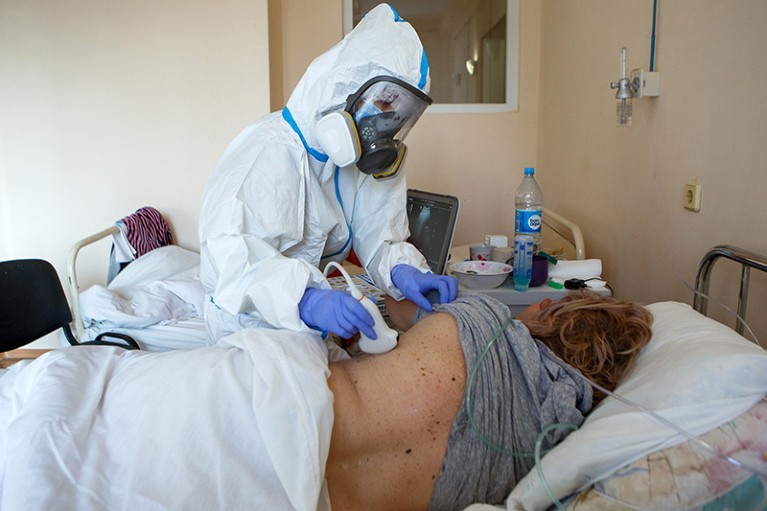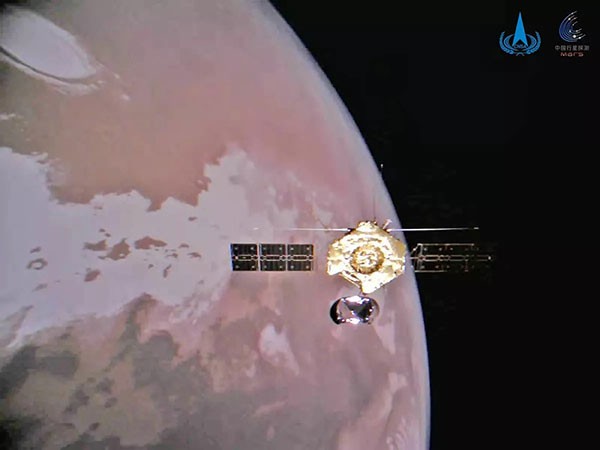Hello Nature readers, would you like to get this Briefing in your inbox free every day? Sign up here.

A doctor in Uzhhorod, Ukraine, examines the lungs of a person with COVID-19. The Omicron variant might affect the lungs less than do previously circulating variants.Credit: Serhii Hudak/Ukrinform/Barcroft Media via Getty
Omicron struggles to infect the lungs
Mounting evidence from animal studies suggests that the Omicron coronavirus variant does not multiply readily in lung tissue. This offers a tantalizing explanation for early hints that it causes less-serious disease than does the Delta variant: Omicron might not infect cells deep in the lung as readily as those in the upper airways. Experiments in lung cells and lung organoids suggest that this could be because of a protein called TMPRSS2, which protrudes from the surfaces of many cells in the lungs. Omicron struggles to infect cells through TMPRSS2. Scientists emphasize that Omicron still threatens to overload health systems because of its hyper-transmissibility.
Reference: Research Square preprint, bioRxiv preprint 1, bioRxiv preprint 2, bioRxiv preprint 3, bioRxiv preprint 4 and medRxiv preprint (all not peer reviewed)
Fatal lab blast highlights safety in China
On 24 October, two people died following an explosion at the Nanjing University of Aeronautics and Astronautics. The deaths are the latest in a series of fatalities caused by explosions in academic laboratories in China, often involving students in chemistry departments. The tragedies have some scientists in China concerned about a lack of oversight and standardized safety protocols, especially in teaching labs.
Stars might form way faster than we thought
A gas cloud could coalesce into a baby star ten times quicker than previously thought. Astronomers observed that the feeble magnetic fields outside the core of Lynds 1544, the beginnings of a star that’s forming in the Taurus Molecular Cloud, are even weaker than predicted. That gives gravity free rein in that region to crush enough gas together to spark nuclear fusion. “The paper basically says that gravity wins in the cloud: that’s where stars start to form, not in the dense core,” says astrophysicist Paola Caselli. “If this is proven to be the case in other gas clouds, it will be revolutionary for the star formation community.”
Features & opinion
An artist’s eye for viral structures
Crystallographer Donald Caspar, who died on 27 November, defined the rules that govern the self-assembly of simple viruses. This laid the foundations for a new way of thinking about the molecular systems that regulate and drive all living cells. Caspar was known for his brilliance, kindness and passion for Grecian urns — and for his loquaciousness, writes longtime-colleague Lee Makowski. “Group members would set a lab timer before going to ask him a question,” says Makowski. “When the timer went off, they could plead the need to check an experiment.”
How to exit a job gracefully
Whatever the circumstances of a departure from a position, there are ways to ensure that you leave on good terms, say experts and scientists who have done so. The key is to be open and transparent about your reasons for leaving, and to try to reduce the impact of your departure on staff members. If you're offered an exit interview, use it as an opportunity to offer frank, constructive feedback on the role — don’t just air grievances. “It’s good to leave on a good note, and then to leave it behind,” says Rosemary Guyatt, general manager of people and culture at the Australian Human Resources Institute.
Don’t Look Up shows science denial myths
The satirical film Don’t Look Up, in which an asteroid stands in for the threat of climate change, handily demonstrates the myths that bolster science denial, write research psychologists Gale Sinatra and Barbara Hofer. From the idea that we can’t act unless the science is 100% certain to the belief that technology alone will save us, they spell out five misconceptions to watch out for — and how to combat them.
Image of the week

China's Tianwen-1 Mars orbiter captured this stunning selfie above the red planet by jettisoning a small camera that beamed its photos back to the mothership over Wi-Fi. (Space.com | 5 min read)CNSA/PEC
